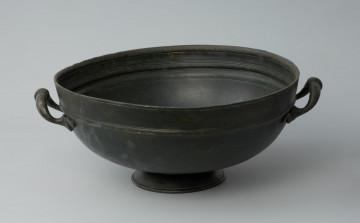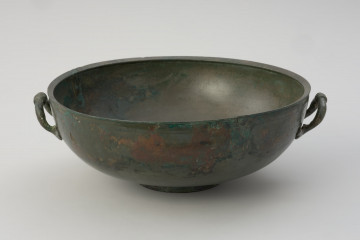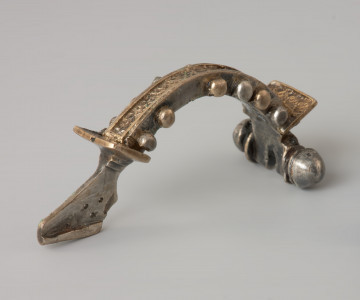
Bowl on foot
National Museum in Szczecin
Part of the collection: Antiquity
The Roman bronze saucepan was found in Sierosław in a richly furnished inhumation grave covered with stone pavement. The burial was discovered by chance in the 1890s during sand extraction. Initially, the hoard consisted of two bronze vessels (the other preserved only in fragments), four bronze fibulae, a silver pin, a bronze needle, and two bronze belt fittings. At the end of World War II, the items were evacuated from the Museum. Currently, the set of items from Sierosław lacks one fibula, which probably went missing during the move, and is enriched by a piece of pottery that initially was not a part of the original burial objects. The presented saucepan has a flat bottom and narrowed handle with a hole. It is ornamented, below the spout, with shallow, carved lines running around the vessel. The handle is decorated similarly along the edges. The Sierosław burial should be associated with the population of the Gustow group, and dated to the second half of the 1st century. The saucepan is part of the group of objects from the Roman import, which occurred outside the Roman Empire as a result of the so-called “Slovak flood.” It was manufactured probably in the Capua region, in the vicinity of Naples – the well-known foundry facility that produced bronze and silver vessels. The presence of many imported goods in the grave from Sierosław indicates an extensive trade network of the population from the Western Pomerania region.
Monika Witek
Author / creator
Dimensions
cały obiekt: height: 6 cm, width: 26.3 cm, diameter: 7.5 cm
Object type
furnishings and equipment; container; vessel (container); saucepan
Technique
casting
Material
bronze
Creation / finding place
Owner
Muzeum Narodowe w Szczecinie
Identification number
Location / status

National Museum in Szczecin

National Museum in Szczecin

National Museum in Szczecin
DISCOVER this TOPIC
National Museum in Szczecin
DISCOVER this PATH
Educational path